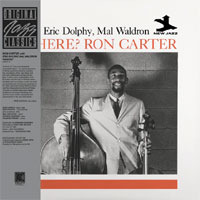Ron Carter • Where? New Jazz/Craft Recordings CR00718
Over the next several years Carter played primarily in bands led by Randy Weston and Bobby Timmons. Along the way he played on tour with Miles Davis and turned down a job offer or two. In 1963, he joined what became the second great Miles Davis Quintet (once Wayne Shorter joined in 1964). Before joining, however, he had played bass on numerous iconic albums, including Dolphy's Out There and Far Cry, and Gil Evans’ Out Of The Cool, all recorded in late 1960. Rudy Van Gelder recorded Where? on June 20, 1961. It was Carter’s first effort as a leader, and it featured Dolphy on bass clarinet, alto saxophone and flute; Mal Waldron on piano; George Duvivier on bass; and Charles Persip on drums. Carter plays both cello and bass. Duvivier covers bass duties on the three numbers where Carter plays cello, and on the appropriately named “Bass Duet,” along with Carter. Dolphy is the main soloist, performing on bass clarinet, alto saxophone, and flute. The sheer variety of instrumental virtuosity is enhanced by the range of instruments Carter and Dolphy play. The music and performances are not as “out there” as most of the albums recorded in Dolphy’s name, and Carter is not yet the creative force that he would be in a few years. Nonetheless, it is fascinating music. I particularly connect with the cuts where Dolphy solos on flute, which reminds me of the scene where Steve McQueen saunters into the Coffee Cantata nightclub in San Francisco in the movie Bullitt, with the jazz quartet Meridian West featuring flute and bass. That was one of the beginnings of my love affair with jazz (and San Francisco), and Where? makes the Bullit soundtrack performance seem a bit insipid, while conjuring some of the same warm feelings. If you judge music by its review on the All Music website before plopping down your money (you know who you are), ignore the slightly lukewarm three-star review there, as the musical performance is far better than the review suggests. The original album was released in mono only. This new reissue is in stereo, despite what looks like a mono cover. The album first turned up in stereo in 1967 as a Japanese reissue. In 1971, it was reissued in the US under Dolphy’s name; this was the first US release in stereo. By 1961, Van Gelder was recording in stereo only; mono releases were folded down from the stereo tapes. Van Gelder Studio recordings of the time were typically released simultaneously in stereo and mono versions. Why this release did not follow that pattern is a mystery. The cover is a facsimile of the original cover. The broad
white border of the original was a dirt magnet, in part because of the textured paper
used, but experienced collectors knew it could be cleaned with an application of
Sterling’s Magic All Purpose Cleaner. The textured paper used for the cover of the
reissue is a close match to that of the original cover and starts out bright and clean.
The mastering job by Kevin Gray is exceptional. The stereo image is not too artificially
re-created, with holes between left, center, and right instruments, and the instrumental
tone is a big improvement from the original's. |

 assist Ron Carter
is often described as the most recorded jazz artist of all time. Born in 1937, he is still
active today, so longevity provides one explanation for his productivity. Add to that the
fact that he is one of the greatest bass players of all time, and that adds up to a lot of
opportunities to record. Born in the Detroit area, where he attended Cass Tech High
School, famous for its music program, Carter moved to New York in 1959 and for about a
year played in Chico Hamilton’s band with Eric Dolphy, although he arrived a few
months too late to play on Hamilton’s three Warner Brothers titles featuring Dolphy (The
Three Faces Of Chico, With Strings Attached and Gongs East!).
assist Ron Carter
is often described as the most recorded jazz artist of all time. Born in 1937, he is still
active today, so longevity provides one explanation for his productivity. Add to that the
fact that he is one of the greatest bass players of all time, and that adds up to a lot of
opportunities to record. Born in the Detroit area, where he attended Cass Tech High
School, famous for its music program, Carter moved to New York in 1959 and for about a
year played in Chico Hamilton’s band with Eric Dolphy, although he arrived a few
months too late to play on Hamilton’s three Warner Brothers titles featuring Dolphy (The
Three Faces Of Chico, With Strings Attached and Gongs East!).